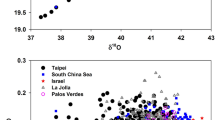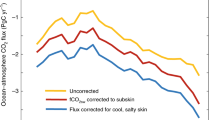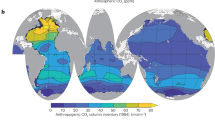Abstract
RADIOCARBON produced naturally in the upper atmosphere or arti-ficially during nuclear weapons testing is the main tracer used to validate models of oceanic carbon cycling, in particular the exchange of carbon dioxide with the atmosphere1–3 and the mixing parameters within the ocean itself4–7. Here we test the overall consistency of exchange fluxes between all relevant compartments in a simple model of the global carbon cycle, using measurements of the long-term tropospheric CO2 concentration8 and radiocarbon composition9–12, the bomb 14C inventory in the stratosphere13,14 and a compilation of bomb detonation dates and strengths15. We find that to balance the budget, we must invoke an extra source to account for 25% of the generally accepted uptake of bomb 14C by the oceans3. The strength of this source decreases from 1970 onwards, with a characteristic timescale similar to that of the ocean uptake. Significant radiocarbon transport from the remote high stratosphere and significantly reduced uptake of bomb 14C by the biosphere can both be ruled out by observational constraints. We therefore conclude that the global oceanic bomb 14C inventory should be revised downwards. A smaller oceanic bomb 14C inventory also implies a smaller oceanic radiocarbon penetration depth16, which in turn implies that the oceans take up 25% less anthropogenic CO2 than had previously been believed.
This is a preview of subscription content, access via your institution
Access options
Subscribe to this journal
Receive 51 print issues and online access
$199.00 per year
only $3.90 per issue
Buy this article
- Purchase on Springer Link
- Instant access to full article PDF
Prices may be subject to local taxes which are calculated during checkout
Similar content being viewed by others
References
Stuiver, M. J. geophys. Res. 85, 2711–2718 (1980).
Stuiver, M., Oestlund, H. G. & McConnaughey, T. A. in SCOPE 16, Carbon Cycle Modelling (ed. Bolin, B.) 201–221 (Wiley, New York, 1981).
Broecker, W. S., Peng, T. H., Östlund, G. & Stuiver, M. J. geophys. Res. 90, 6953–6970 (1985).
Oeschger, H., Siegenthaler, U., Schotterer, U. & Gugelmann, A. Tellus 27, 168–192 (1975).
Siegenthaler, U. J. geophys. Res. 88, 3599–3608 (1983).
Toggweiler, J. R., Dixon, K. & Bryan, K. J. geophys. Res. 94, 8217–8242 (1989).
Maier-Reimer, E. Globl Biogeochem. Cycles 7, 645–677 (1993).
Keeling, C. D. & Whorf, T. P. in Trends 90 (eds Boden, T. A., Kanciruk, P. & Farrell, M. P.) 8–9 (Oak Ridge natn. Lab., Oak Ridge, 1990).
Levin, I. et al. Radiocarbon 27, 1–19 (1985).
Levin, I., Kromer, B., Wagenbach, D. & Münnich, K. O. Tellus 39B, 89–95 (1987).
Manning, M. et al. Radiocarbon 32, 37–58 (1990).
Levin, I. et al. in Radiocarbon After Four Decades: an Interdisciplinary Perspective (eds Taylor, R. E., Long, A. & Kra, R.) 503–518 (Springer, New York, 1992).
Tans, P. P. in SCOPE 16, Carbon Cycle Modelling (ed. Bolin, B.) 131–157 (Wiley, New York, 1981).
Telegadas, K. in Report HASL 243 12–187 (N.T.I.S., Springfield, Virginia, 1971).
Rath, H. K. thesis, Univ. Heidelberg (1988).
Siegenthaler, U. & Sarmiento, G. Nature 365, 119–125 (1993).
Siegenthaler, U. & Joos, F. Tellus 44B, 186–207 (1992).
Harrison, K., Broecker, W. S. & Bonani, G., Globl Biogeochem. Cycles 7, 69–80 (1993).
Siegenthaler, U. & Oeschger, H. Tellus 39B, 140–154 (1987).
Suess, H. E. Science 122, 415–417 (1955).
Bonka, H. in Strahlenschutzprobleme im Zusammenhang mit der Verwendung von Tritium und Kohlenstoff-14 und ihren Verbindungen (eds Stieve, F. E. & Kirstner, G.) 17–26 (Dietrich Reimer, Berlin, 1980).
UNSCEAR 1993 Report to the General Assembly (United Nations Publication, Sales No. E.94.IX.2).
UNSCEAR 1982 Report to the General Assembly (United Nations Publication, Sales No. E.82.IX.8).
Machta, L., List, R. J. & Telegadas, K. in Congress of the U.S., Hearing before Subcommittee in Research, Development and Radiation of the Joint Committee of Atomic Energy, 88th Congress 46–61 (1963).
Damon, P. & Sternberg, R. Radiocarbon 31, 697–703 (1989).
Nakamura, T. et al. Radiocarbon 34, 745–752 (1992).
Rasch, P. J., Tie, X. X., Boville, B. A. & Williamson, D. L. J. geophys. Res. 99, 999–1017 (1994).
Goudriaan, J. J. Expl. Bot. 43, 1111–1119 (1992).
Peng, T. H. & Broecker, W. S. in Abstr. 4th International CO2 Conf. (eds Lambert, G. & Merlivat, L.) 214 (WMO-GAW-Report No. 89, WMO/TD-NO 561, Geneva, 1993).
Liss, P. & Merlivat, L. in The Role of Air-Sea Exchange in Geochemical Cycling (ed. Buat-Ménard, P.) 113–127 (Reidel, Dordrecht, 1986).
Watson, A. in The Global Carbon Cycle (ed. Heimann, M.) 397–412 (Springer, Heidelberg, 1993).
Broecker, W. S., Peng, T. H. & Engh, R. Radiocarbon 22, 565–598 (1980).
Stuiver, M. & Quay, P. Earth planet. Sci. Lett. 53, 349–362 (1981).
Stuiver, M. & Polach, H. A. Radiocarbon 19, 355–363 (1977).
Author information
Authors and Affiliations
Rights and permissions
About this article
Cite this article
Hesshaimer, V., Heimann, M. & Levin, I. Radiocarbon evidence for a smaller oceanic carbon dioxide sink than previously believed. Nature 370, 201–203 (1994). https://doi.org/10.1038/370201a0
Received:
Accepted:
Issue Date:
DOI: https://doi.org/10.1038/370201a0
This article is cited by
-
Sub-annual bomb radiocarbon records from trees in northern Israel
Scientific Reports (2023)
-
14C studies in the vicinity of the Czech NPPs
Journal of Radioanalytical and Nuclear Chemistry (2012)
-
Seeking carbon-consistency in the climate-science-to-policy interface
Biogeochemistry (2011)
-
Tropospheric 14CO2 at Wellington, New Zealand: the world’s longest record
Biogeochemistry (2011)
Comments
By submitting a comment you agree to abide by our Terms and Community Guidelines. If you find something abusive or that does not comply with our terms or guidelines please flag it as inappropriate.



